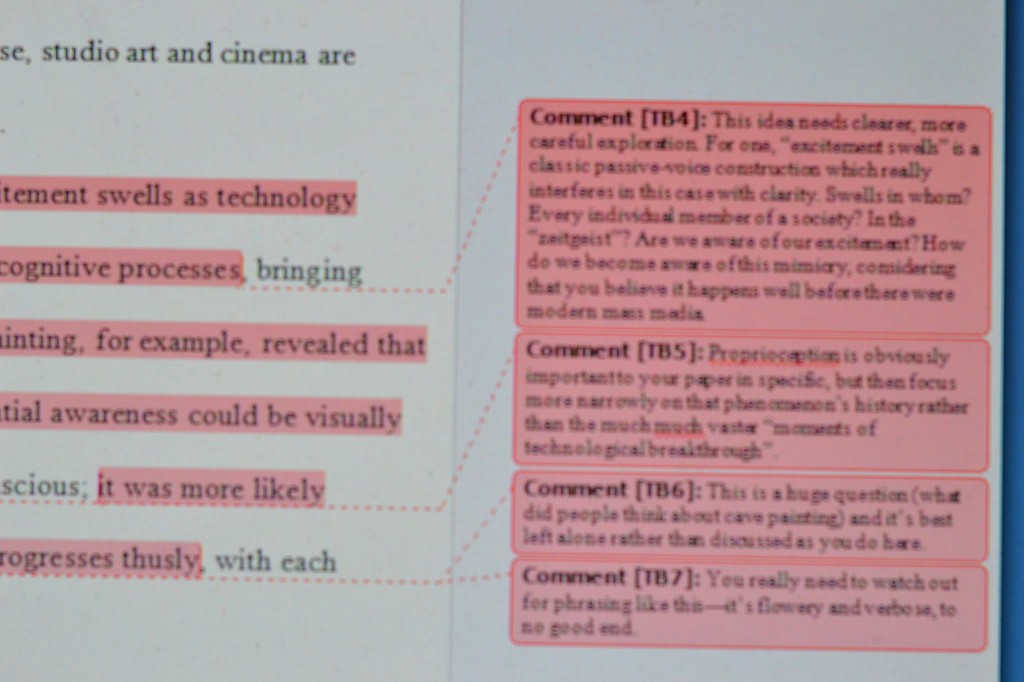Grading, finishing today after having eaten up most of Memorial Day. Just as well, I wasn’t about to try serious gardening in the heat.
I’ve been slowly shifting over to paperless grading. I have enough of an attachment to marking a printed paper that I still sometimes mark the paper once, loosely, by hand and then copy over comments to a digital copy. The digital copy has some advantages beyond allowing potentially for paperless exchanges. Most usefully, it means I retain a copy of the paper with my comments, which comes in very handy when I have to write recommendations, do advising for the student or otherwise have a track record of their past work for me.
Grading is as much of a chore for me as it is for most academics. It is interesting to think about why it’s easily the most hated part of the job.
For one, at least in the humanities and soft social sciences, it’s all too easy to be aware of how arbitrary and fine-shaded the distinction between grades can be. I tend to agonize a lot over the difference between A- and B+, since I regard both of those as strong grades designating good work. A clear A is usually easier to recognize, and grades below a B- tend to involve either serious problems with the quality of the work or other considerations such as seriously late or missing work, which is also a lot easier to discern.
Another issue is that when you have a larger group of assignments to grade, the common or repeated patterns and issues tend to get mind-numbing after a while. I have to keep reminding myself not to punish whomever I’m grading near the end simply for the bad luck of doing something I’ve seen before. (One reason that I don’t put a final grade on a paper until I’ve seen at least half the total set.) There is an unavoidable tedium involved in any group of papers or tests larger than 15 unless the assignment actively encourages a very wide spread of individual creativity or discretion.


I’m a huge fan of using the Grademark feature of turnitin.com. It speeds my grading, allows me to store comments that I frequently use, and puts the comment on the paper where it belongs. The anti-plagiarism features are nice, but to me the real gift of the software is the Grademark features.
I’ve become a big fan of paperless grading this last year, partly for the “having a copy” aspect, and partly because I find that I grade more efficiently when I’m typing rather than handwriting. Plus, if the student revises, it gives me a basis for comparison, so I can tell whether the revision is a real rethinking of the issue, or just typo-hunting.
I’ll also create forms to handle those “typical problems” you mention; that is, in addition to the specific assessment of the individual paper, I’ll also note in a general way how it did with regard to broad technical issues – organization, spelling and typos, effectiveness of thesis, etc. So I can go through the checklist of typical paper problems fairly quickly, and then turn to the specific concerns of a particular student’s argument.
I think part of what makes grading so tedious is that it requires the same level of thought and care as other academic work, but with most of the creativity stripped out. As you note, unless a student does something startling or unexpected, most of one’s responses are going to be fairly predictable, and, as one gets more experienced, one’s ability to state the problem in succinct yet routinized ways improves. This indeed makes for boredom!
Indeed, I have found that, for my survey students, it’s more fruitful to do several small assignments than one large one, because the character of the students’ strengths and weaknesses is usually revealed within a paragraph or two – so unless part of the lesson is to write at length, it’s not worth having them write more than a page or so at a time. (And if the assignments can build on each other, so much the better. With the level I’ve been teaching, having them put all their eggs in one basket is a recipe for disaster for them.) So they get more feedback over the course of the semester, and because the assignments are short, they are less painful to grade.